Financial Analysis for HR Managers
VerifiedAdded on 2019/09/20
|10
|2243
|291
Report
AI Summary
This report provides a detailed financial analysis of UDG Healthcare and Spire Healthcare, two companies in the healthcare industry. The analysis includes liquidity, profitability, leverage, and efficiency ratios, as well as key HR metrics. The report compares the performance of both companies over two years, concluding that UDG Healthcare generally outperforms Spire Healthcare. Recommendations are made for Spire Healthcare to improve its financial and operational performance. The report also includes a table of contents and references.

Information Management & Financial Analysis for HR Managers
Paraphrase This Document
Need a fresh take? Get an instant paraphrase of this document with our AI Paraphraser
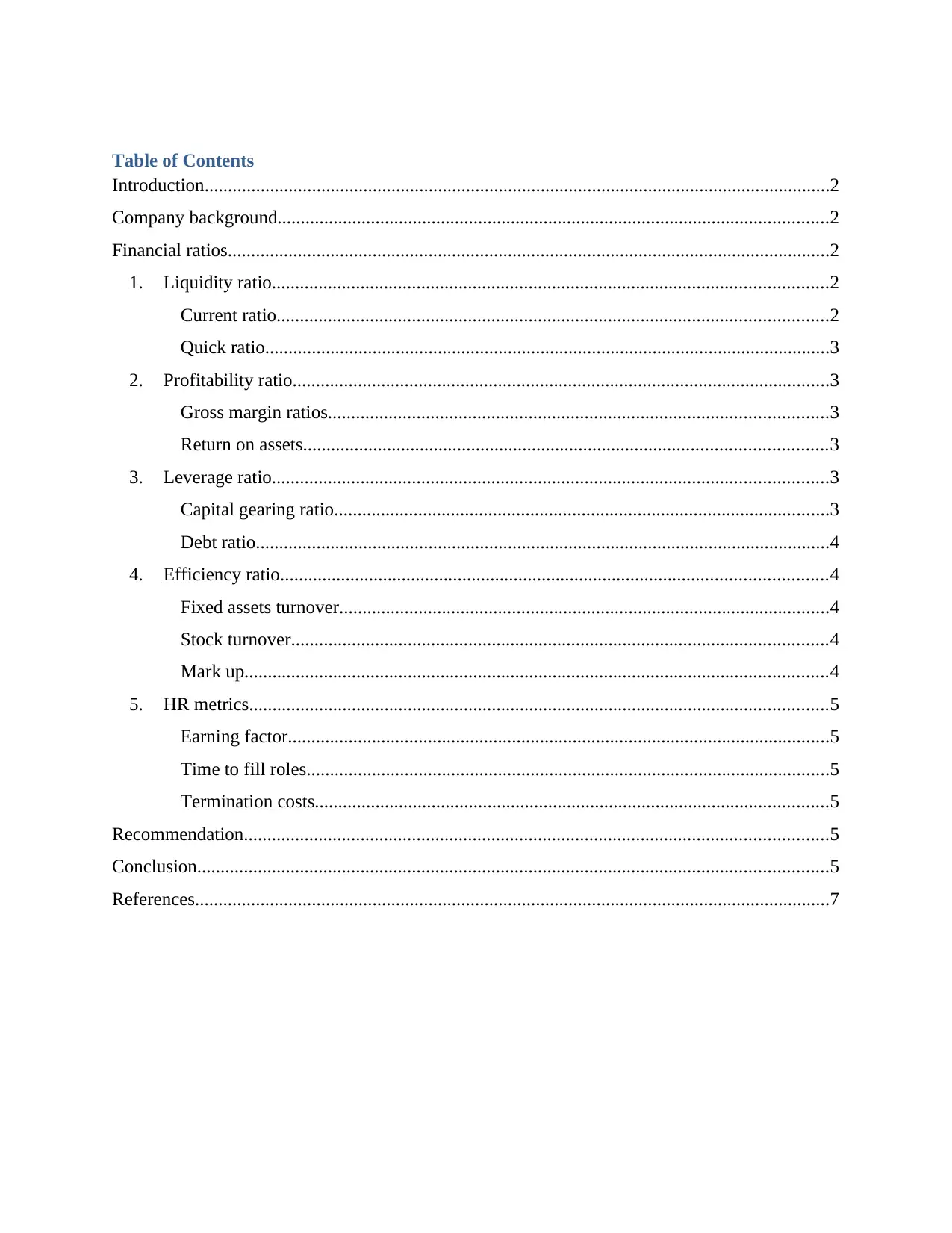
Table of Contents
Introduction......................................................................................................................................2
Company background......................................................................................................................2
Financial ratios.................................................................................................................................2
1. Liquidity ratio.......................................................................................................................2
Current ratio......................................................................................................................2
Quick ratio.........................................................................................................................3
2. Profitability ratio...................................................................................................................3
Gross margin ratios...........................................................................................................3
Return on assets................................................................................................................3
3. Leverage ratio.......................................................................................................................3
Capital gearing ratio..........................................................................................................3
Debt ratio...........................................................................................................................4
4. Efficiency ratio.....................................................................................................................4
Fixed assets turnover.........................................................................................................4
Stock turnover...................................................................................................................4
Mark up.............................................................................................................................4
5. HR metrics............................................................................................................................5
Earning factor....................................................................................................................5
Time to fill roles................................................................................................................5
Termination costs..............................................................................................................5
Recommendation.............................................................................................................................5
Conclusion.......................................................................................................................................5
References........................................................................................................................................7
Introduction......................................................................................................................................2
Company background......................................................................................................................2
Financial ratios.................................................................................................................................2
1. Liquidity ratio.......................................................................................................................2
Current ratio......................................................................................................................2
Quick ratio.........................................................................................................................3
2. Profitability ratio...................................................................................................................3
Gross margin ratios...........................................................................................................3
Return on assets................................................................................................................3
3. Leverage ratio.......................................................................................................................3
Capital gearing ratio..........................................................................................................3
Debt ratio...........................................................................................................................4
4. Efficiency ratio.....................................................................................................................4
Fixed assets turnover.........................................................................................................4
Stock turnover...................................................................................................................4
Mark up.............................................................................................................................4
5. HR metrics............................................................................................................................5
Earning factor....................................................................................................................5
Time to fill roles................................................................................................................5
Termination costs..............................................................................................................5
Recommendation.............................................................................................................................5
Conclusion.......................................................................................................................................5
References........................................................................................................................................7
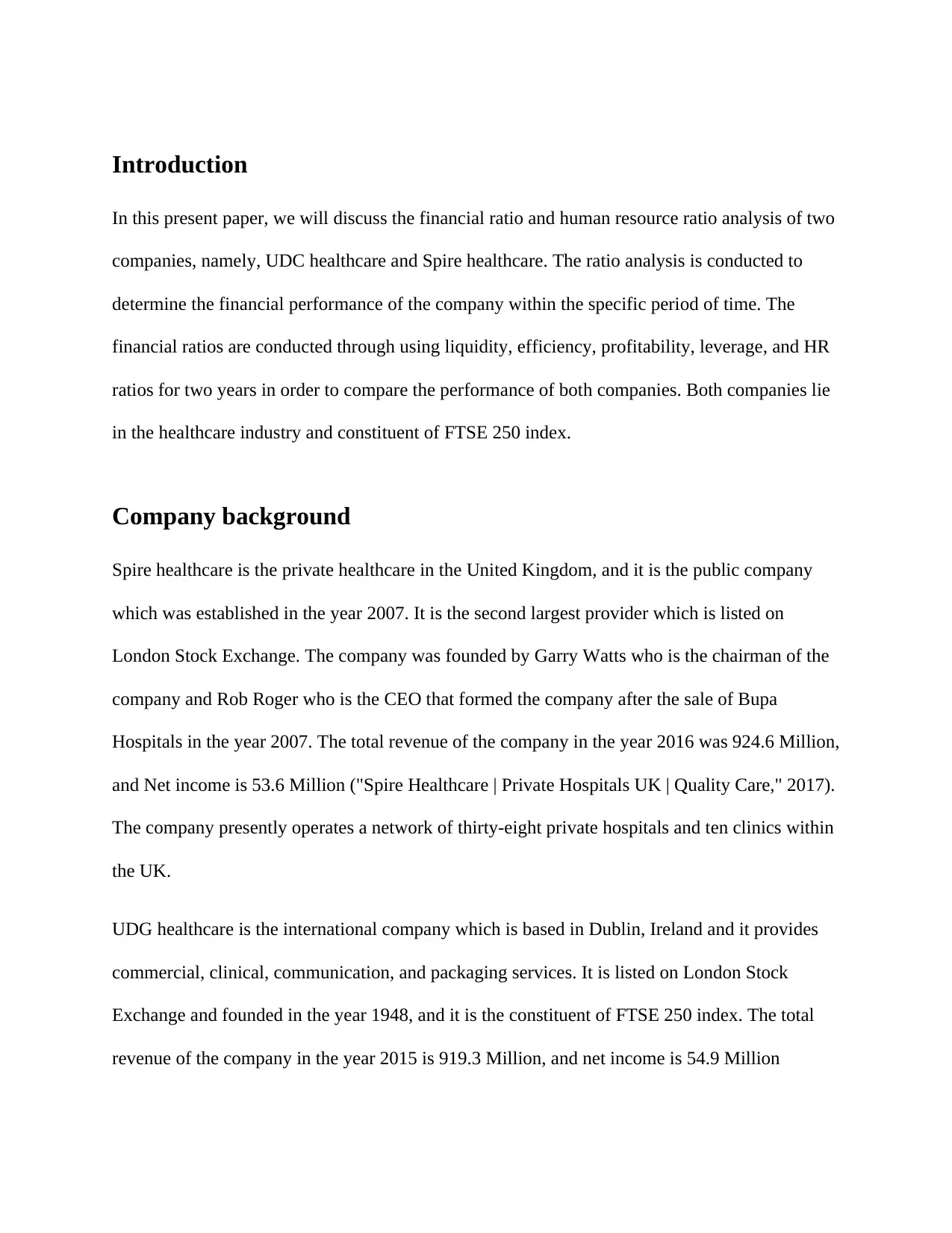
Introduction
In this present paper, we will discuss the financial ratio and human resource ratio analysis of two
companies, namely, UDC healthcare and Spire healthcare. The ratio analysis is conducted to
determine the financial performance of the company within the specific period of time. The
financial ratios are conducted through using liquidity, efficiency, profitability, leverage, and HR
ratios for two years in order to compare the performance of both companies. Both companies lie
in the healthcare industry and constituent of FTSE 250 index.
Company background
Spire healthcare is the private healthcare in the United Kingdom, and it is the public company
which was established in the year 2007. It is the second largest provider which is listed on
London Stock Exchange. The company was founded by Garry Watts who is the chairman of the
company and Rob Roger who is the CEO that formed the company after the sale of Bupa
Hospitals in the year 2007. The total revenue of the company in the year 2016 was 924.6 Million,
and Net income is 53.6 Million ("Spire Healthcare | Private Hospitals UK | Quality Care," 2017).
The company presently operates a network of thirty-eight private hospitals and ten clinics within
the UK.
UDG healthcare is the international company which is based in Dublin, Ireland and it provides
commercial, clinical, communication, and packaging services. It is listed on London Stock
Exchange and founded in the year 1948, and it is the constituent of FTSE 250 index. The total
revenue of the company in the year 2015 is 919.3 Million, and net income is 54.9 Million
In this present paper, we will discuss the financial ratio and human resource ratio analysis of two
companies, namely, UDC healthcare and Spire healthcare. The ratio analysis is conducted to
determine the financial performance of the company within the specific period of time. The
financial ratios are conducted through using liquidity, efficiency, profitability, leverage, and HR
ratios for two years in order to compare the performance of both companies. Both companies lie
in the healthcare industry and constituent of FTSE 250 index.
Company background
Spire healthcare is the private healthcare in the United Kingdom, and it is the public company
which was established in the year 2007. It is the second largest provider which is listed on
London Stock Exchange. The company was founded by Garry Watts who is the chairman of the
company and Rob Roger who is the CEO that formed the company after the sale of Bupa
Hospitals in the year 2007. The total revenue of the company in the year 2016 was 924.6 Million,
and Net income is 53.6 Million ("Spire Healthcare | Private Hospitals UK | Quality Care," 2017).
The company presently operates a network of thirty-eight private hospitals and ten clinics within
the UK.
UDG healthcare is the international company which is based in Dublin, Ireland and it provides
commercial, clinical, communication, and packaging services. It is listed on London Stock
Exchange and founded in the year 1948, and it is the constituent of FTSE 250 index. The total
revenue of the company in the year 2015 is 919.3 Million, and net income is 54.9 Million
⊘ This is a preview!⊘
Do you want full access?
Subscribe today to unlock all pages.

Trusted by 1+ million students worldwide
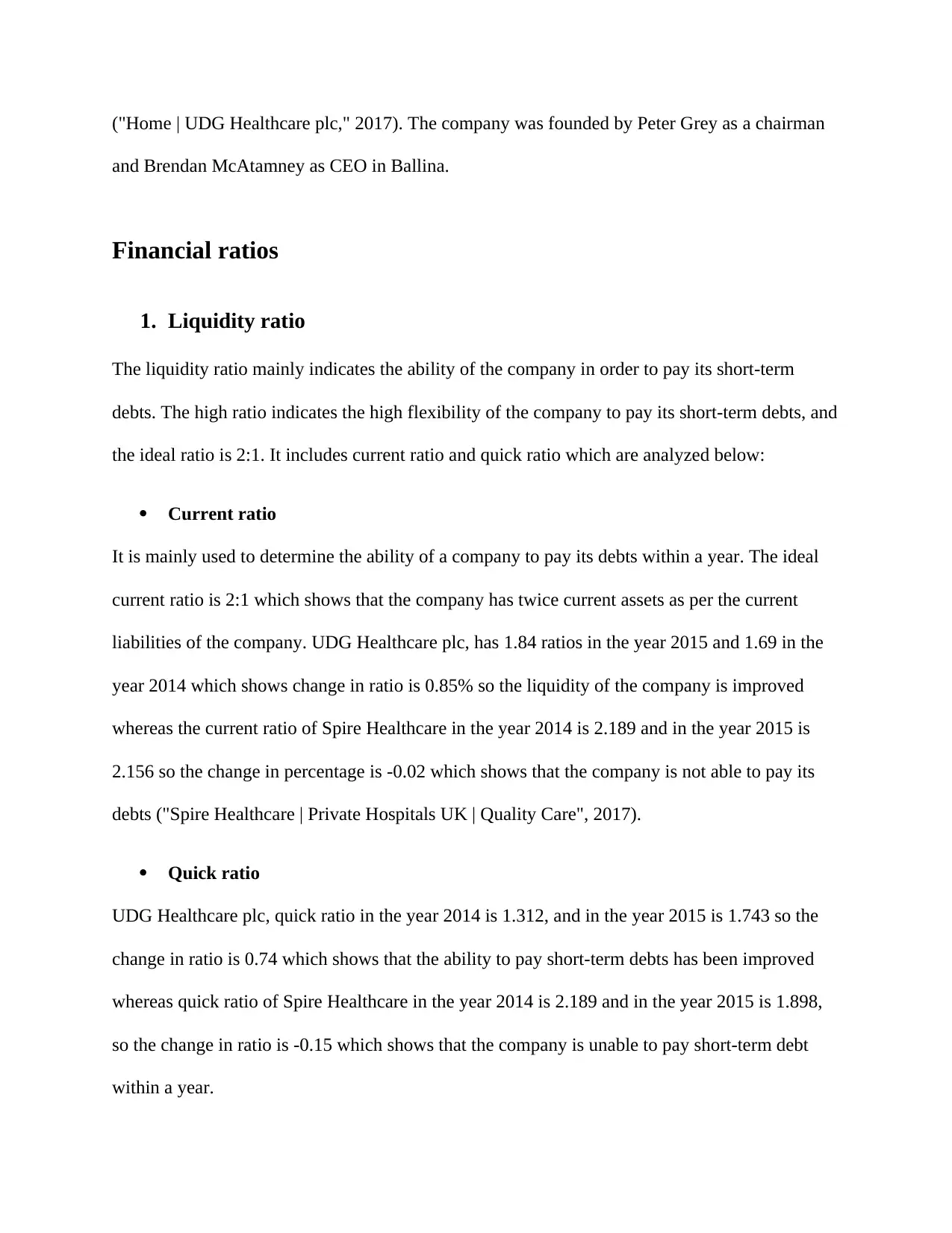
("Home | UDG Healthcare plc," 2017). The company was founded by Peter Grey as a chairman
and Brendan McAtamney as CEO in Ballina.
Financial ratios
1. Liquidity ratio
The liquidity ratio mainly indicates the ability of the company in order to pay its short-term
debts. The high ratio indicates the high flexibility of the company to pay its short-term debts, and
the ideal ratio is 2:1. It includes current ratio and quick ratio which are analyzed below:
Current ratio
It is mainly used to determine the ability of a company to pay its debts within a year. The ideal
current ratio is 2:1 which shows that the company has twice current assets as per the current
liabilities of the company. UDG Healthcare plc, has 1.84 ratios in the year 2015 and 1.69 in the
year 2014 which shows change in ratio is 0.85% so the liquidity of the company is improved
whereas the current ratio of Spire Healthcare in the year 2014 is 2.189 and in the year 2015 is
2.156 so the change in percentage is -0.02 which shows that the company is not able to pay its
debts ("Spire Healthcare | Private Hospitals UK | Quality Care", 2017).
Quick ratio
UDG Healthcare plc, quick ratio in the year 2014 is 1.312, and in the year 2015 is 1.743 so the
change in ratio is 0.74 which shows that the ability to pay short-term debts has been improved
whereas quick ratio of Spire Healthcare in the year 2014 is 2.189 and in the year 2015 is 1.898,
so the change in ratio is -0.15 which shows that the company is unable to pay short-term debt
within a year.
and Brendan McAtamney as CEO in Ballina.
Financial ratios
1. Liquidity ratio
The liquidity ratio mainly indicates the ability of the company in order to pay its short-term
debts. The high ratio indicates the high flexibility of the company to pay its short-term debts, and
the ideal ratio is 2:1. It includes current ratio and quick ratio which are analyzed below:
Current ratio
It is mainly used to determine the ability of a company to pay its debts within a year. The ideal
current ratio is 2:1 which shows that the company has twice current assets as per the current
liabilities of the company. UDG Healthcare plc, has 1.84 ratios in the year 2015 and 1.69 in the
year 2014 which shows change in ratio is 0.85% so the liquidity of the company is improved
whereas the current ratio of Spire Healthcare in the year 2014 is 2.189 and in the year 2015 is
2.156 so the change in percentage is -0.02 which shows that the company is not able to pay its
debts ("Spire Healthcare | Private Hospitals UK | Quality Care", 2017).
Quick ratio
UDG Healthcare plc, quick ratio in the year 2014 is 1.312, and in the year 2015 is 1.743 so the
change in ratio is 0.74 which shows that the ability to pay short-term debts has been improved
whereas quick ratio of Spire Healthcare in the year 2014 is 2.189 and in the year 2015 is 1.898,
so the change in ratio is -0.15 which shows that the company is unable to pay short-term debt
within a year.
Paraphrase This Document
Need a fresh take? Get an instant paraphrase of this document with our AI Paraphraser
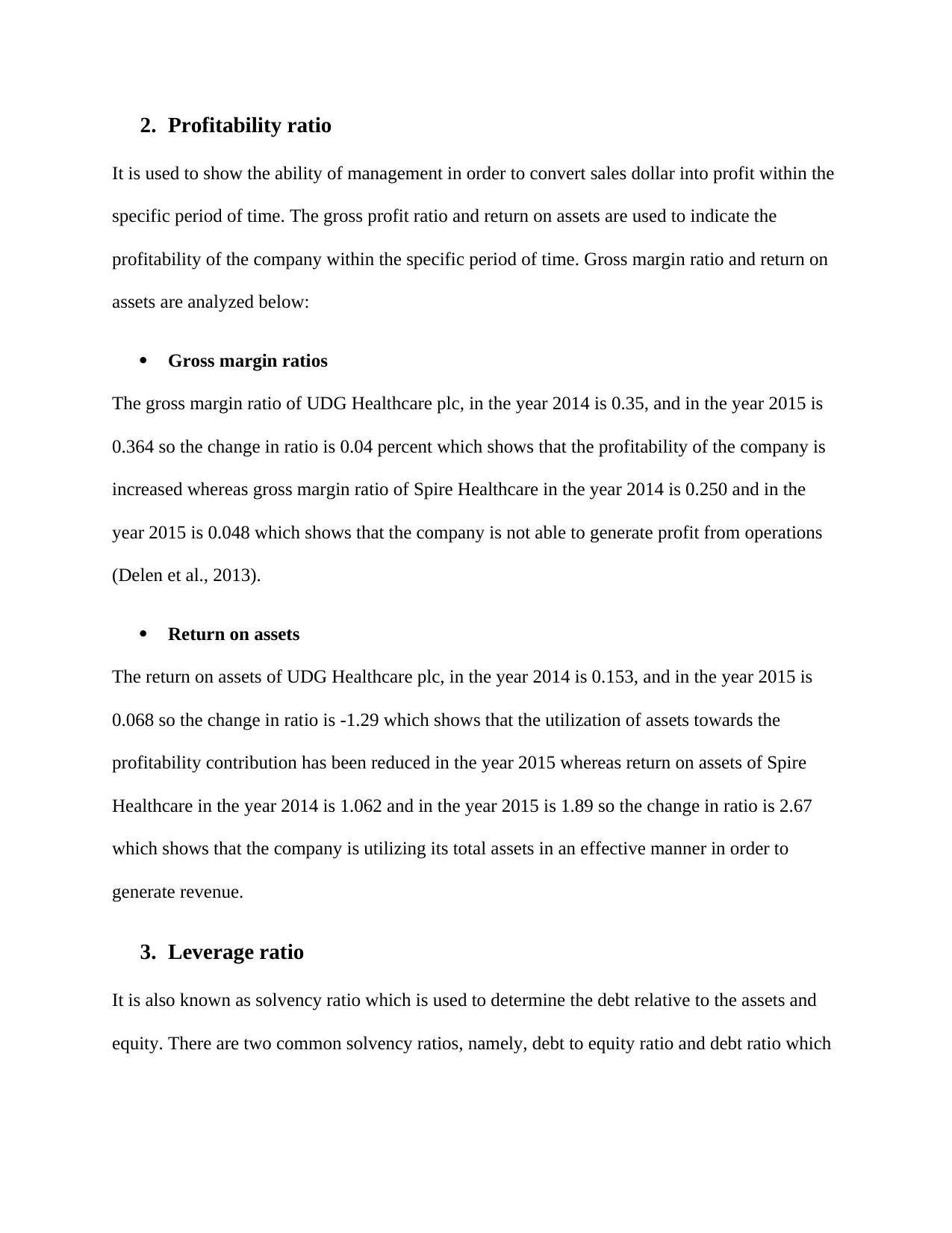
2. Profitability ratio
It is used to show the ability of management in order to convert sales dollar into profit within the
specific period of time. The gross profit ratio and return on assets are used to indicate the
profitability of the company within the specific period of time. Gross margin ratio and return on
assets are analyzed below:
Gross margin ratios
The gross margin ratio of UDG Healthcare plc, in the year 2014 is 0.35, and in the year 2015 is
0.364 so the change in ratio is 0.04 percent which shows that the profitability of the company is
increased whereas gross margin ratio of Spire Healthcare in the year 2014 is 0.250 and in the
year 2015 is 0.048 which shows that the company is not able to generate profit from operations
(Delen et al., 2013).
Return on assets
The return on assets of UDG Healthcare plc, in the year 2014 is 0.153, and in the year 2015 is
0.068 so the change in ratio is -1.29 which shows that the utilization of assets towards the
profitability contribution has been reduced in the year 2015 whereas return on assets of Spire
Healthcare in the year 2014 is 1.062 and in the year 2015 is 1.89 so the change in ratio is 2.67
which shows that the company is utilizing its total assets in an effective manner in order to
generate revenue.
3. Leverage ratio
It is also known as solvency ratio which is used to determine the debt relative to the assets and
equity. There are two common solvency ratios, namely, debt to equity ratio and debt ratio which
It is used to show the ability of management in order to convert sales dollar into profit within the
specific period of time. The gross profit ratio and return on assets are used to indicate the
profitability of the company within the specific period of time. Gross margin ratio and return on
assets are analyzed below:
Gross margin ratios
The gross margin ratio of UDG Healthcare plc, in the year 2014 is 0.35, and in the year 2015 is
0.364 so the change in ratio is 0.04 percent which shows that the profitability of the company is
increased whereas gross margin ratio of Spire Healthcare in the year 2014 is 0.250 and in the
year 2015 is 0.048 which shows that the company is not able to generate profit from operations
(Delen et al., 2013).
Return on assets
The return on assets of UDG Healthcare plc, in the year 2014 is 0.153, and in the year 2015 is
0.068 so the change in ratio is -1.29 which shows that the utilization of assets towards the
profitability contribution has been reduced in the year 2015 whereas return on assets of Spire
Healthcare in the year 2014 is 1.062 and in the year 2015 is 1.89 so the change in ratio is 2.67
which shows that the company is utilizing its total assets in an effective manner in order to
generate revenue.
3. Leverage ratio
It is also known as solvency ratio which is used to determine the debt relative to the assets and
equity. There are two common solvency ratios, namely, debt to equity ratio and debt ratio which
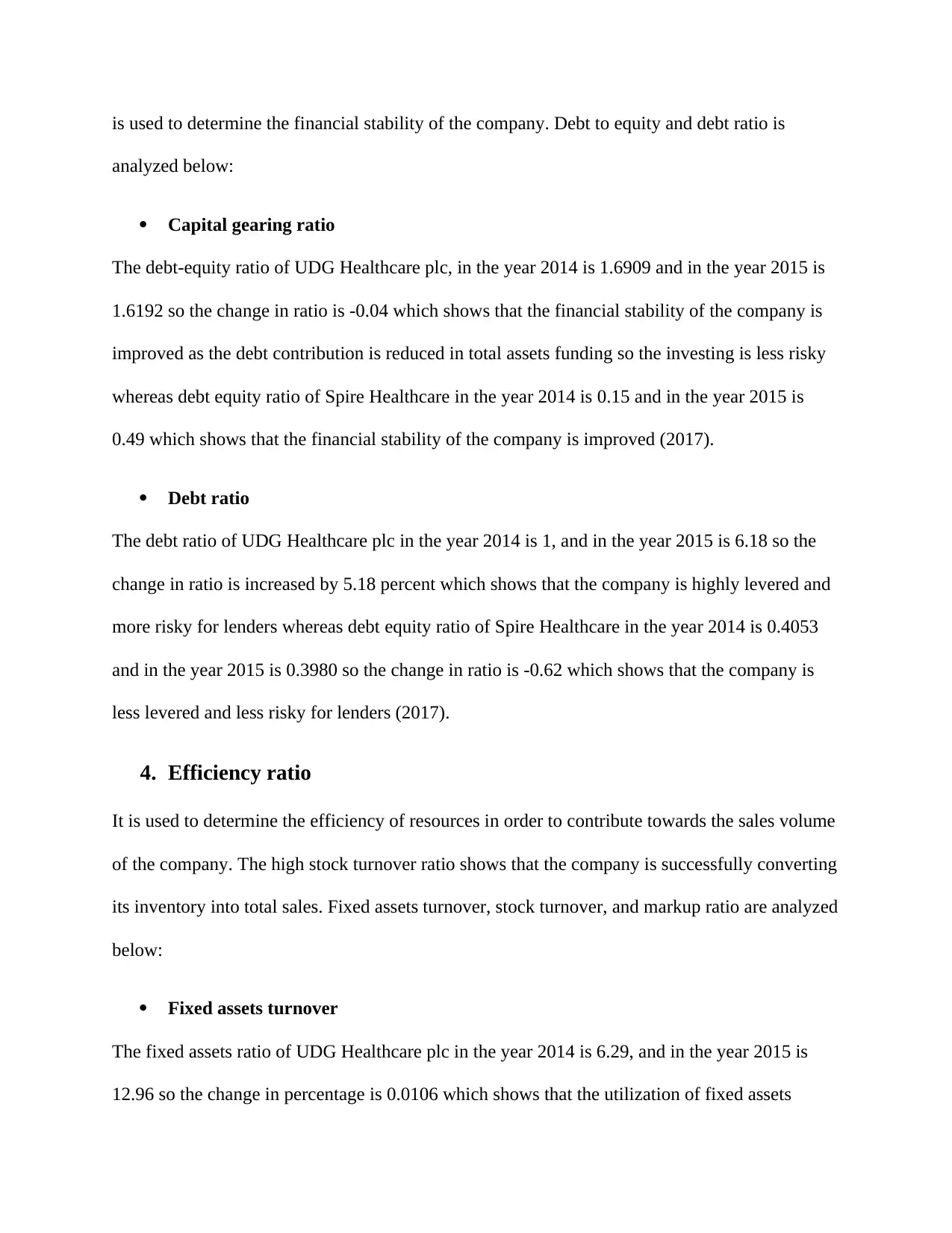
is used to determine the financial stability of the company. Debt to equity and debt ratio is
analyzed below:
Capital gearing ratio
The debt-equity ratio of UDG Healthcare plc, in the year 2014 is 1.6909 and in the year 2015 is
1.6192 so the change in ratio is -0.04 which shows that the financial stability of the company is
improved as the debt contribution is reduced in total assets funding so the investing is less risky
whereas debt equity ratio of Spire Healthcare in the year 2014 is 0.15 and in the year 2015 is
0.49 which shows that the financial stability of the company is improved (2017).
Debt ratio
The debt ratio of UDG Healthcare plc in the year 2014 is 1, and in the year 2015 is 6.18 so the
change in ratio is increased by 5.18 percent which shows that the company is highly levered and
more risky for lenders whereas debt equity ratio of Spire Healthcare in the year 2014 is 0.4053
and in the year 2015 is 0.3980 so the change in ratio is -0.62 which shows that the company is
less levered and less risky for lenders (2017).
4. Efficiency ratio
It is used to determine the efficiency of resources in order to contribute towards the sales volume
of the company. The high stock turnover ratio shows that the company is successfully converting
its inventory into total sales. Fixed assets turnover, stock turnover, and markup ratio are analyzed
below:
Fixed assets turnover
The fixed assets ratio of UDG Healthcare plc in the year 2014 is 6.29, and in the year 2015 is
12.96 so the change in percentage is 0.0106 which shows that the utilization of fixed assets
analyzed below:
Capital gearing ratio
The debt-equity ratio of UDG Healthcare plc, in the year 2014 is 1.6909 and in the year 2015 is
1.6192 so the change in ratio is -0.04 which shows that the financial stability of the company is
improved as the debt contribution is reduced in total assets funding so the investing is less risky
whereas debt equity ratio of Spire Healthcare in the year 2014 is 0.15 and in the year 2015 is
0.49 which shows that the financial stability of the company is improved (2017).
Debt ratio
The debt ratio of UDG Healthcare plc in the year 2014 is 1, and in the year 2015 is 6.18 so the
change in ratio is increased by 5.18 percent which shows that the company is highly levered and
more risky for lenders whereas debt equity ratio of Spire Healthcare in the year 2014 is 0.4053
and in the year 2015 is 0.3980 so the change in ratio is -0.62 which shows that the company is
less levered and less risky for lenders (2017).
4. Efficiency ratio
It is used to determine the efficiency of resources in order to contribute towards the sales volume
of the company. The high stock turnover ratio shows that the company is successfully converting
its inventory into total sales. Fixed assets turnover, stock turnover, and markup ratio are analyzed
below:
Fixed assets turnover
The fixed assets ratio of UDG Healthcare plc in the year 2014 is 6.29, and in the year 2015 is
12.96 so the change in percentage is 0.0106 which shows that the utilization of fixed assets
⊘ This is a preview!⊘
Do you want full access?
Subscribe today to unlock all pages.

Trusted by 1+ million students worldwide
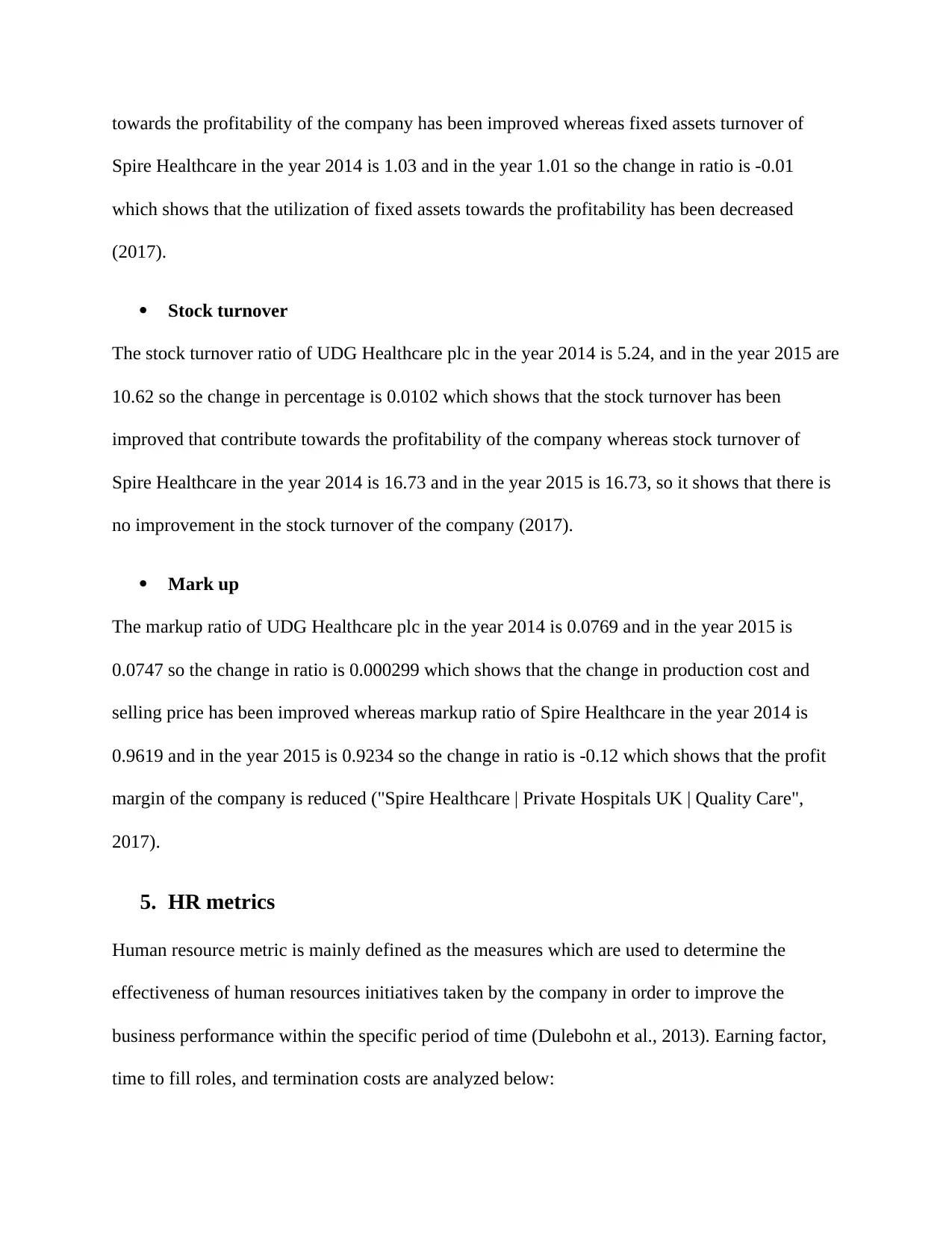
towards the profitability of the company has been improved whereas fixed assets turnover of
Spire Healthcare in the year 2014 is 1.03 and in the year 1.01 so the change in ratio is -0.01
which shows that the utilization of fixed assets towards the profitability has been decreased
(2017).
Stock turnover
The stock turnover ratio of UDG Healthcare plc in the year 2014 is 5.24, and in the year 2015 are
10.62 so the change in percentage is 0.0102 which shows that the stock turnover has been
improved that contribute towards the profitability of the company whereas stock turnover of
Spire Healthcare in the year 2014 is 16.73 and in the year 2015 is 16.73, so it shows that there is
no improvement in the stock turnover of the company (2017).
Mark up
The markup ratio of UDG Healthcare plc in the year 2014 is 0.0769 and in the year 2015 is
0.0747 so the change in ratio is 0.000299 which shows that the change in production cost and
selling price has been improved whereas markup ratio of Spire Healthcare in the year 2014 is
0.9619 and in the year 2015 is 0.9234 so the change in ratio is -0.12 which shows that the profit
margin of the company is reduced ("Spire Healthcare | Private Hospitals UK | Quality Care",
2017).
5. HR metrics
Human resource metric is mainly defined as the measures which are used to determine the
effectiveness of human resources initiatives taken by the company in order to improve the
business performance within the specific period of time (Dulebohn et al., 2013). Earning factor,
time to fill roles, and termination costs are analyzed below:
Spire Healthcare in the year 2014 is 1.03 and in the year 1.01 so the change in ratio is -0.01
which shows that the utilization of fixed assets towards the profitability has been decreased
(2017).
Stock turnover
The stock turnover ratio of UDG Healthcare plc in the year 2014 is 5.24, and in the year 2015 are
10.62 so the change in percentage is 0.0102 which shows that the stock turnover has been
improved that contribute towards the profitability of the company whereas stock turnover of
Spire Healthcare in the year 2014 is 16.73 and in the year 2015 is 16.73, so it shows that there is
no improvement in the stock turnover of the company (2017).
Mark up
The markup ratio of UDG Healthcare plc in the year 2014 is 0.0769 and in the year 2015 is
0.0747 so the change in ratio is 0.000299 which shows that the change in production cost and
selling price has been improved whereas markup ratio of Spire Healthcare in the year 2014 is
0.9619 and in the year 2015 is 0.9234 so the change in ratio is -0.12 which shows that the profit
margin of the company is reduced ("Spire Healthcare | Private Hospitals UK | Quality Care",
2017).
5. HR metrics
Human resource metric is mainly defined as the measures which are used to determine the
effectiveness of human resources initiatives taken by the company in order to improve the
business performance within the specific period of time (Dulebohn et al., 2013). Earning factor,
time to fill roles, and termination costs are analyzed below:
Paraphrase This Document
Need a fresh take? Get an instant paraphrase of this document with our AI Paraphraser
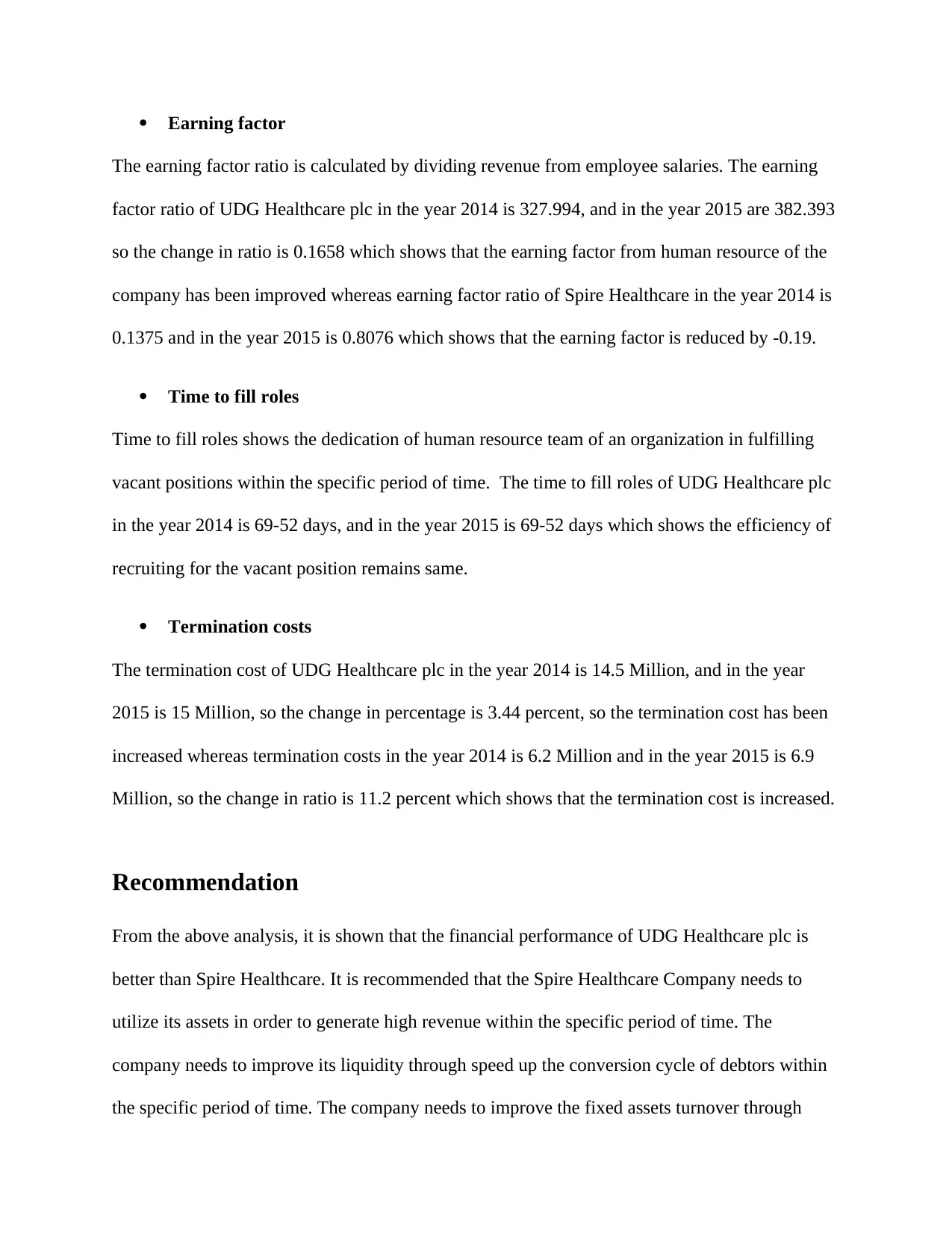
Earning factor
The earning factor ratio is calculated by dividing revenue from employee salaries. The earning
factor ratio of UDG Healthcare plc in the year 2014 is 327.994, and in the year 2015 are 382.393
so the change in ratio is 0.1658 which shows that the earning factor from human resource of the
company has been improved whereas earning factor ratio of Spire Healthcare in the year 2014 is
0.1375 and in the year 2015 is 0.8076 which shows that the earning factor is reduced by -0.19.
Time to fill roles
Time to fill roles shows the dedication of human resource team of an organization in fulfilling
vacant positions within the specific period of time. The time to fill roles of UDG Healthcare plc
in the year 2014 is 69-52 days, and in the year 2015 is 69-52 days which shows the efficiency of
recruiting for the vacant position remains same.
Termination costs
The termination cost of UDG Healthcare plc in the year 2014 is 14.5 Million, and in the year
2015 is 15 Million, so the change in percentage is 3.44 percent, so the termination cost has been
increased whereas termination costs in the year 2014 is 6.2 Million and in the year 2015 is 6.9
Million, so the change in ratio is 11.2 percent which shows that the termination cost is increased.
Recommendation
From the above analysis, it is shown that the financial performance of UDG Healthcare plc is
better than Spire Healthcare. It is recommended that the Spire Healthcare Company needs to
utilize its assets in order to generate high revenue within the specific period of time. The
company needs to improve its liquidity through speed up the conversion cycle of debtors within
the specific period of time. The company needs to improve the fixed assets turnover through
The earning factor ratio is calculated by dividing revenue from employee salaries. The earning
factor ratio of UDG Healthcare plc in the year 2014 is 327.994, and in the year 2015 are 382.393
so the change in ratio is 0.1658 which shows that the earning factor from human resource of the
company has been improved whereas earning factor ratio of Spire Healthcare in the year 2014 is
0.1375 and in the year 2015 is 0.8076 which shows that the earning factor is reduced by -0.19.
Time to fill roles
Time to fill roles shows the dedication of human resource team of an organization in fulfilling
vacant positions within the specific period of time. The time to fill roles of UDG Healthcare plc
in the year 2014 is 69-52 days, and in the year 2015 is 69-52 days which shows the efficiency of
recruiting for the vacant position remains same.
Termination costs
The termination cost of UDG Healthcare plc in the year 2014 is 14.5 Million, and in the year
2015 is 15 Million, so the change in percentage is 3.44 percent, so the termination cost has been
increased whereas termination costs in the year 2014 is 6.2 Million and in the year 2015 is 6.9
Million, so the change in ratio is 11.2 percent which shows that the termination cost is increased.
Recommendation
From the above analysis, it is shown that the financial performance of UDG Healthcare plc is
better than Spire Healthcare. It is recommended that the Spire Healthcare Company needs to
utilize its assets in order to generate high revenue within the specific period of time. The
company needs to improve its liquidity through speed up the conversion cycle of debtors within
the specific period of time. The company needs to improve the fixed assets turnover through
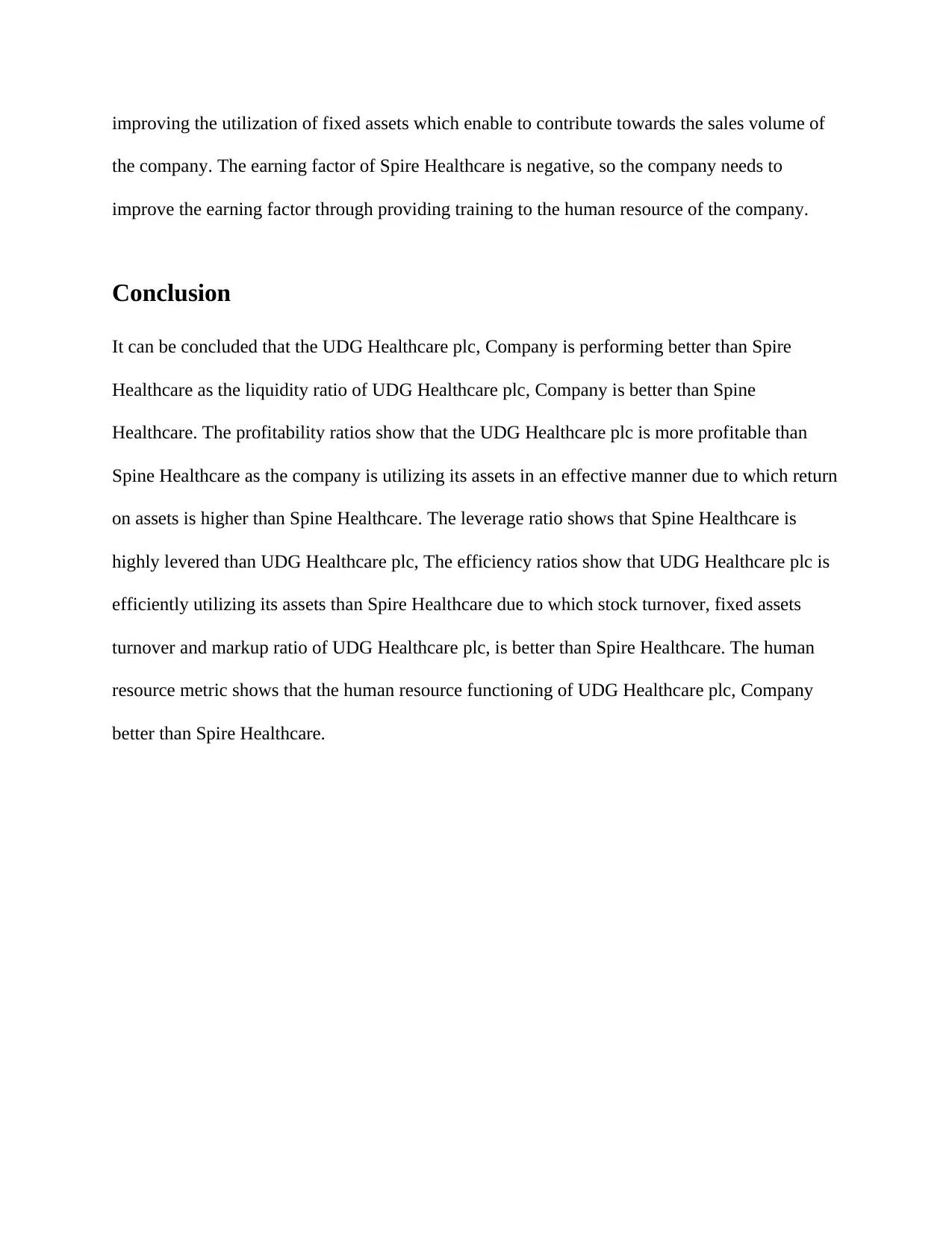
improving the utilization of fixed assets which enable to contribute towards the sales volume of
the company. The earning factor of Spire Healthcare is negative, so the company needs to
improve the earning factor through providing training to the human resource of the company.
Conclusion
It can be concluded that the UDG Healthcare plc, Company is performing better than Spire
Healthcare as the liquidity ratio of UDG Healthcare plc, Company is better than Spine
Healthcare. The profitability ratios show that the UDG Healthcare plc is more profitable than
Spine Healthcare as the company is utilizing its assets in an effective manner due to which return
on assets is higher than Spine Healthcare. The leverage ratio shows that Spine Healthcare is
highly levered than UDG Healthcare plc, The efficiency ratios show that UDG Healthcare plc is
efficiently utilizing its assets than Spire Healthcare due to which stock turnover, fixed assets
turnover and markup ratio of UDG Healthcare plc, is better than Spire Healthcare. The human
resource metric shows that the human resource functioning of UDG Healthcare plc, Company
better than Spire Healthcare.
the company. The earning factor of Spire Healthcare is negative, so the company needs to
improve the earning factor through providing training to the human resource of the company.
Conclusion
It can be concluded that the UDG Healthcare plc, Company is performing better than Spire
Healthcare as the liquidity ratio of UDG Healthcare plc, Company is better than Spine
Healthcare. The profitability ratios show that the UDG Healthcare plc is more profitable than
Spine Healthcare as the company is utilizing its assets in an effective manner due to which return
on assets is higher than Spine Healthcare. The leverage ratio shows that Spine Healthcare is
highly levered than UDG Healthcare plc, The efficiency ratios show that UDG Healthcare plc is
efficiently utilizing its assets than Spire Healthcare due to which stock turnover, fixed assets
turnover and markup ratio of UDG Healthcare plc, is better than Spire Healthcare. The human
resource metric shows that the human resource functioning of UDG Healthcare plc, Company
better than Spire Healthcare.
⊘ This is a preview!⊘
Do you want full access?
Subscribe today to unlock all pages.

Trusted by 1+ million students worldwide
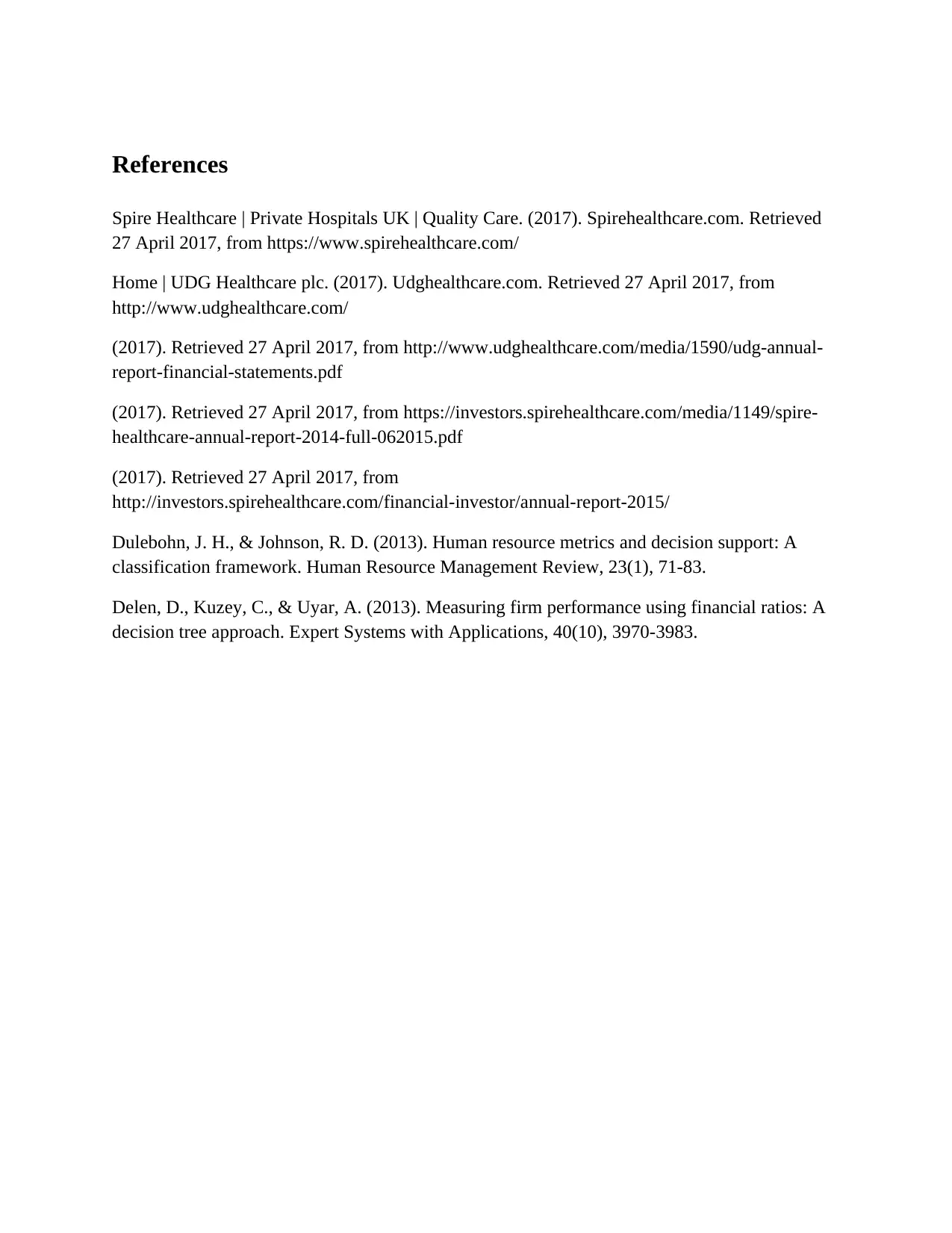
References
Spire Healthcare | Private Hospitals UK | Quality Care. (2017). Spirehealthcare.com. Retrieved
27 April 2017, from https://www.spirehealthcare.com/
Home | UDG Healthcare plc. (2017). Udghealthcare.com. Retrieved 27 April 2017, from
http://www.udghealthcare.com/
(2017). Retrieved 27 April 2017, from http://www.udghealthcare.com/media/1590/udg-annual-
report-financial-statements.pdf
(2017). Retrieved 27 April 2017, from https://investors.spirehealthcare.com/media/1149/spire-
healthcare-annual-report-2014-full-062015.pdf
(2017). Retrieved 27 April 2017, from
http://investors.spirehealthcare.com/financial-investor/annual-report-2015/
Dulebohn, J. H., & Johnson, R. D. (2013). Human resource metrics and decision support: A
classification framework. Human Resource Management Review, 23(1), 71-83.
Delen, D., Kuzey, C., & Uyar, A. (2013). Measuring firm performance using financial ratios: A
decision tree approach. Expert Systems with Applications, 40(10), 3970-3983.
Spire Healthcare | Private Hospitals UK | Quality Care. (2017). Spirehealthcare.com. Retrieved
27 April 2017, from https://www.spirehealthcare.com/
Home | UDG Healthcare plc. (2017). Udghealthcare.com. Retrieved 27 April 2017, from
http://www.udghealthcare.com/
(2017). Retrieved 27 April 2017, from http://www.udghealthcare.com/media/1590/udg-annual-
report-financial-statements.pdf
(2017). Retrieved 27 April 2017, from https://investors.spirehealthcare.com/media/1149/spire-
healthcare-annual-report-2014-full-062015.pdf
(2017). Retrieved 27 April 2017, from
http://investors.spirehealthcare.com/financial-investor/annual-report-2015/
Dulebohn, J. H., & Johnson, R. D. (2013). Human resource metrics and decision support: A
classification framework. Human Resource Management Review, 23(1), 71-83.
Delen, D., Kuzey, C., & Uyar, A. (2013). Measuring firm performance using financial ratios: A
decision tree approach. Expert Systems with Applications, 40(10), 3970-3983.
1 out of 10
Related Documents
Your All-in-One AI-Powered Toolkit for Academic Success.
+13062052269
info@desklib.com
Available 24*7 on WhatsApp / Email
![[object Object]](/_next/static/media/star-bottom.7253800d.svg)
Unlock your academic potential
Copyright © 2020–2026 A2Z Services. All Rights Reserved. Developed and managed by ZUCOL.





